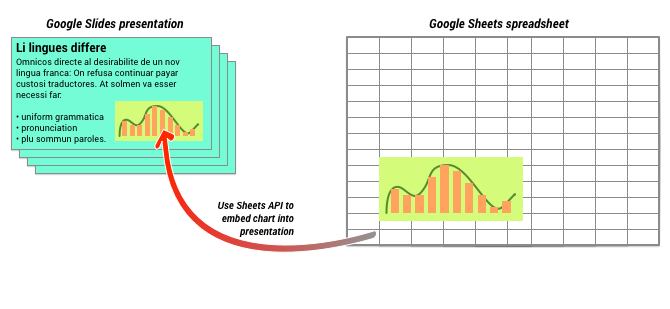Trang này mô tả cách lấy các biểu đồ hiện có từ Google Trang tính và thêm chúng vào bản trình bày trên Google Trang trình bày.
Việc thêm biểu đồ vào bản trình bày có thể giúp tăng sức ảnh hưởng và khiến dữ liệu có ý nghĩa đối với độc giả. Biểu đồ là công cụ mạnh mẽ độc đáo để hiển thị các mẫu hoặc xu hướng trong một tập dữ liệu và có thể giúp bạn truyền đạt rõ ràng về dữ liệu định lượng.
Video trên thảo luận cách tạo trang trình bày từ dữ liệu bảng tính. Phần này bao gồm một ví dụ hoàn chỉnh (Python) về việc thêm biểu đồ vào trang trình bày và cũng nhập dữ liệu ô trong bảng tính vào bảng.
Giới thiệu về cách thêm biểu đồ
Bất cứ khi nào bạn trình bày thông tin định lượng, biểu đồ dữ liệu có thể cải thiện bản trình bày của bạn. API Trang trình bày cho phép bạn thêm mọi biểu đồ mà bạn có thể tạo trong Google Trang tính: biểu đồ thanh, biểu đồ dạng đường, biểu đồ hình tròn và nhiều biểu đồ khác.

Như minh hoạ trong biểu đồ ở trên, trước tiên bạn phải tạo biểu đồ trong Google Trang tính. Khi biểu đồ tồn tại, bạn có thể nhúng biểu đồ đó vào bản trình bày của mình.
Quy trình chung để quản lý các biểu đồ trong bản trình bày của bạn là:
- Tạo biểu đồ trong Google Trang tính.
- Sử dụng API Trang tính để đọc mã biểu đồ của EmbeddedChart thu được.
- Sử dụng CreateSheetsChartRequest một lần để thêm tính năng này vào trang trình bày.
- Sử dụng RefreshSheetsChartRequest nếu cần để đồng bộ hóa bảng tính này với dữ liệu nguồn.
Biểu đồ tĩnh so với biểu đồ được liên kết
Khi bạn sử dụng API để thêm biểu đồ vào bản trình bày, một tham số mà bạn chỉ định là LinkingMode. Điều này xác định xem biểu đồ được thêm dưới dạng hình ảnh tĩnh hay đối tượng có thể được làm mới trong tương lai.
Sử dụng chế độ LINKED trong trường hợp:
- Bạn muốn làm mới biểu đồ trong tương lai, phản ánh các thay đổi trong dữ liệu cơ sở.
- Bạn muốn cộng tác viên có đường liên kết đến bảng tính chứa biểu đồ nguồn.
Sử dụng chế độ NOT_LINKED_IMAGE (tĩnh) trong trường hợp:
- Bạn muốn biểu đồ này không bao giờ thay đổi trong tương lai.
- Bạn không muốn cộng tác viên thấy đường liên kết tới bảng tính nguồn.
Các phạm vi khi truy cập vào Google Trang tính
Khi bạn thêm một biểu đồ vào trang trình bày của mình, API Trang trình bày cần truy cập vào biểu đồ đó trong Google Trang tính. Điều này có nghĩa là yêu cầu của bạn phải sử dụng một trong các phạm vi sau:
https://www.googleapis.com/auth/spreadsheets.readonly(ưu tiên)https://www.googleapis.com/auth/spreadsheetshttps://www.googleapis.com/auth/drive.readonlyhttps://www.googleapis.com/auth/drive
Thường thì bạn nên sử dụng phạm vi spreadsheets.readonly vì phạm vi này hạn chế nhất. Tuy nhiên, nếu ứng dụng của bạn đã sử dụng một trong các phạm vi khác được liệt kê ở trên, thì bạn chỉ cần sử dụng phạm vi đó.
Thêm biểu đồ
Để thêm biểu đồ, bạn cần phải biết mã bảng tính và mã biểu đồ của biểu đồ trong Google Trang tính. Sau đó, bạn gọi phương thức batchUpdate, sử dụng
CreateSheetsChartRequest một lần để thêm biểu đồ.
Ví dụ sau đây sẽ lấy một biểu đồ và thêm biểu đồ đó vào một trang trình bày dưới dạng LINKED để bạn có thể làm mới sau.
Apps Script
Go
Java
JavaScript
Node.js
1.199
Python
Ruby
Làm mới biểu đồ
Nếu đã nhúng một biểu đồ LINKED vào bản trình bày của mình, thì bạn có thể làm mới biểu đồ đó bất cứ lúc nào bằng cách sử dụng RefreshSheetsChartRequest.
Thao tác này sẽ cập nhật biểu đồ để đồng bộ hoá với biểu đồ cơ bản của Trang tính và dữ liệu mà biểu đồ dựa trên đó.
Ví dụ sau đây làm mới một biểu đồ hiện có:
